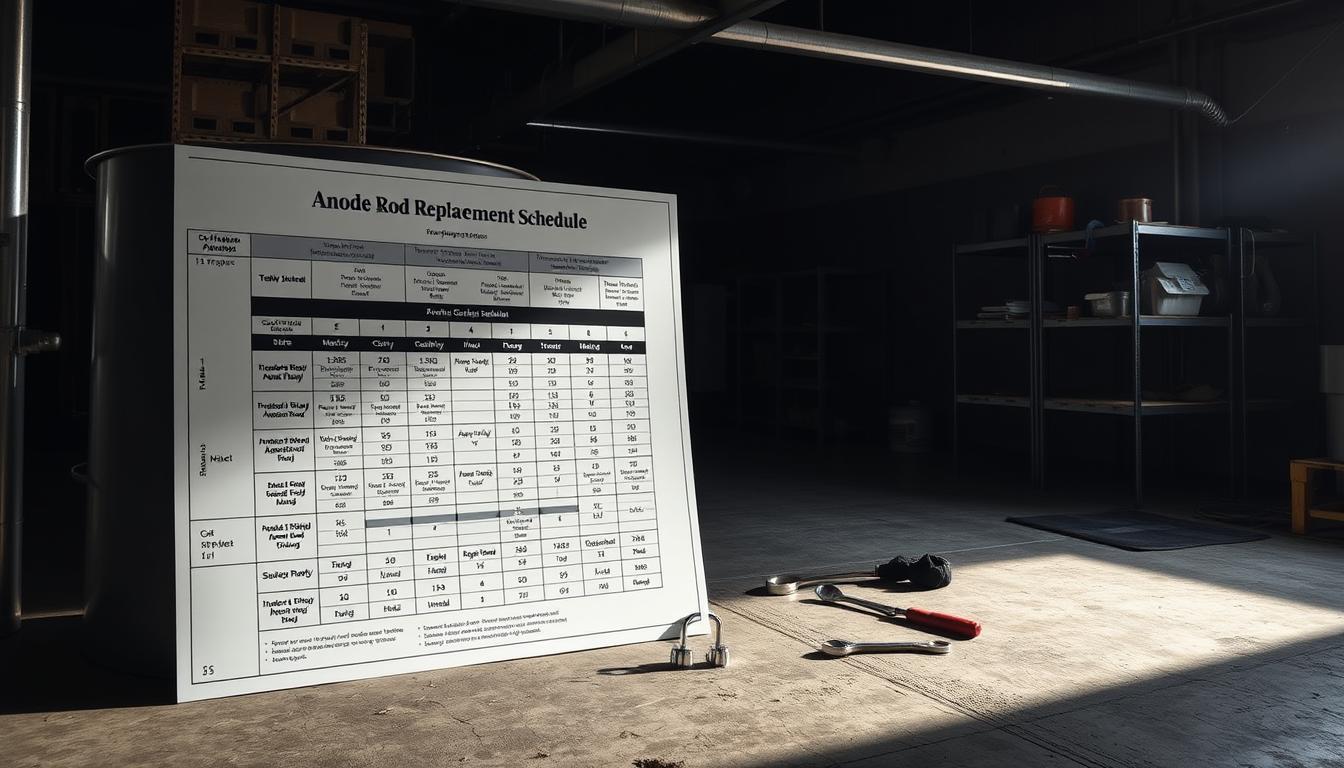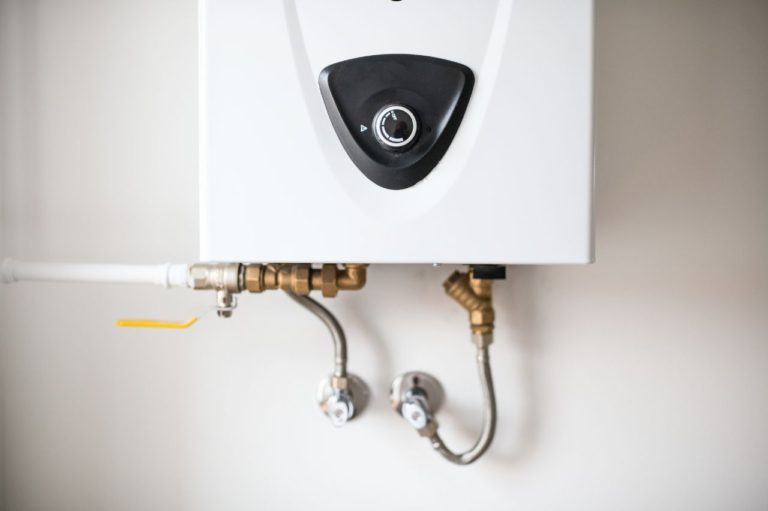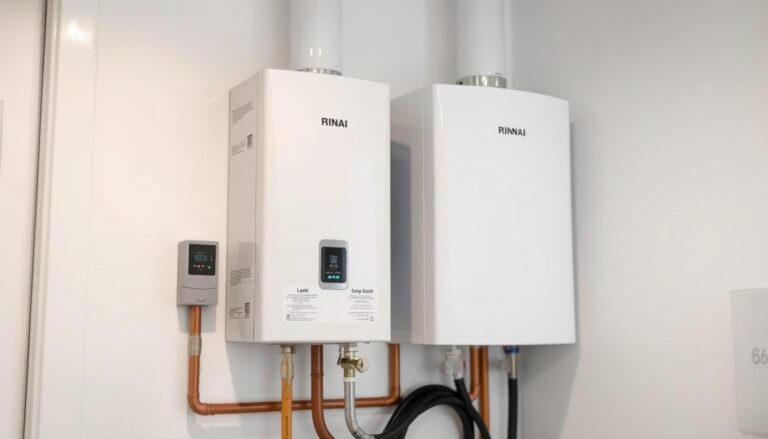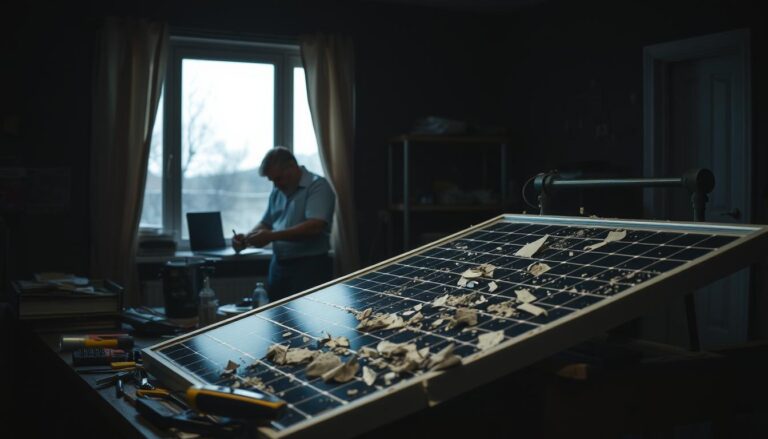Anode Rod Replacement: Know When to Act
Are you aware of the hidden component that protects your water heater from corrosion? The water heater anode rod plays a crucial role in extending the lifespan of your hot water tank. But, like any other component, it has a limited lifespan and needs to be replaced periodically.
Neglecting to replace the anode rod can lead to excessive corrosion, leaks, and damage to your plumbing system. So, how do you know when it’s time to take action? Understanding the signs that indicate the need for replacement is vital to maintaining your water heater’s health.
Key Takeaways
- Regular anode rod replacement is crucial for water heater longevity.
- Neglecting replacement can lead to corrosion and damage.
- Understanding the signs of wear is key to timely replacement.
- A well-maintained anode rod protects your plumbing system.
- Periodic inspection can help determine the replacement schedule.
Understanding the Role of Anode Rods in Water Heaters
Understanding the function of an anode rod is key to appreciating its importance in water heater maintenance. An anode rod is a long metal rod inside the water heater tank, typically made of magnesium or aluminum, designed to protect the tank from corrosion.
What Is an Anode Rod and How Does It Work?
The anode rod works through a process known as sacrificial corrosion, where it attracts corrosive elements in the water, such as iron and minerals, thereby preventing them from corroding the tank. This sacrificial process is crucial for extending the lifespan of your water heater. By corroding in place of the tank, the anode rod ensures that your water heater remains in good condition for a longer period.
“The anode rod is essentially a ‘sacrificial lamb’ that takes the hit from corrosive elements, safeguarding the integrity of your water heater tank,” as noted by water heater maintenance experts. This highlights the importance of anode rod maintenance in overall water heater care.
Why Anode Rods Are Critical for Water Heater Longevity
Anode rods are critical for water heater longevity because they directly impact the tank’s lifespan. A deteriorated anode rod can lead to accelerated tank corrosion, potentially resulting in leaks and costly repairs. Regular inspection and replacement of the anode rod are essential to maintain the water heater’s efficiency and prolong its service life.
By ensuring that the anode rod is in good condition, homeowners can avoid premature water heater replacement, saving both time and money. The importance of anode rod maintenance cannot be overstated, as it plays a vital role in the overall health of the water heater.
When Should Anode Rod Be Replaced: The General Timeline
Understanding when to replace the anode rod in your water heater is crucial for maintaining its efficiency and longevity. The anode rod is a sacrificial component designed to protect the water heater tank from corrosion. Over time, it deteriorates, and if not replaced, it can lead to tank failure.
The Average Lifespan of an Anode Rod
The average lifespan of an anode rod varies depending on several factors, including water quality, usage patterns, and the type of anode rod used. Typically, an anode rod lasts between three to five years. However, this can be shorter or longer depending on the specific conditions.
Manufacturer Recommendations for Replacement Schedules
Different manufacturers may have varying recommendations for anode rod replacement. Some suggest inspecting the anode rod every two years, while others recommend replacement at specific intervals, such as every three to five years. It’s essential to consult your water heater’s manual for the manufacturer’s recommended maintenance schedule.
How Water Heater Age Affects Replacement Frequency
The age of your water heater also plays a significant role in determining how often to inspect or replace the anode rod. For older water heaters, more frequent inspections are recommended because the tank is more susceptible to corrosion. As your water heater ages, the anode rod may need to be replaced more often to protect the tank.
Regular inspection and replacement of the anode rod are critical for extending the life of your water heater. By understanding the general timeline for anode rod replacement and following manufacturer recommendations, you can ensure your water heater operates efficiently and effectively for years to come.
5 Clear Signs Your Anode Rod Needs Immediate Attention
Understanding when your anode rod needs replacement is essential for preventing damage to your water heater. The anode rod is a critical component that protects your water heater from corrosion, and its failure can lead to significant issues.
Visual Indicators of a Deteriorating Anode Rod
One of the most straightforward signs that your anode rod is failing is visible deterioration. If upon inspection, you find that the rod is heavily corroded or significantly worn down, it’s a clear indication that it needs to be replaced. Regular inspections can help identify this issue early on.
Unusual Smells or Discolored Water
If you notice that your water has a rotten egg smell or is discolored, it could be a sign that your anode rod is failing. The rod’s deterioration can lead to the presence of bacteria in the water, causing these issues.
Noises Coming from Your Water Heater
Unusual noises, such as rumbling or banging sounds, coming from your water heater can indicate that sediment has built up due to anode rod failure. This sediment can cause the heater to work less efficiently and make these noises.
Decreased Hot Water Efficiency
A decrease in your water heater’s efficiency, resulting in lukewarm water or longer heating times, can be a sign that the anode rod is no longer functioning correctly.
Visible Corrosion on Tank Components
If you notice visible corrosion on other components of your water heater tank, it’s likely that the anode rod is not doing its job, leaving these parts vulnerable to corrosion.
| Signs | Description |
|---|---|
| Visual Deterioration | Heavy corrosion or significant wear on the anode rod |
| Unusual Smells/Discolored Water | Rotten egg smell or discolored water due to bacterial presence |
| Noises from Water Heater | Rumling or banging sounds due to sediment buildup |
| Decreased Efficiency | Lukewarm water or longer heating times |
| Visible Corrosion | Corrosion on other tank components due to anode rod failure |
Factors That Accelerate Anode Rod Deterioration
Understanding the factors that affect anode rod deterioration is crucial for maintaining your water heater’s efficiency and prolonging its lifespan. The anode rod’s primary function is to protect the water heater tank from corrosion by sacrificing itself. However, its lifespan can be significantly influenced by various factors.
Water Quality and Mineral Content
The quality of the water and its mineral content play a significant role in determining the anode rod’s lifespan. Water with high levels of minerals such as calcium and magnesium can accelerate the corrosion process. Hard water, in particular, can reduce the anode rod’s effectiveness, leading to a shorter lifespan.
Water Softener Systems and Their Impact
Water softener systems, while beneficial for reducing scale buildup, can also impact the anode rod’s deterioration rate. Softened water tends to be more corrosive, potentially accelerating the anode rod’s consumption. It’s essential to monitor the anode rod’s condition more frequently if you have a water softener system installed.
High Water Temperature Settings
High water temperature settings can also accelerate anode rod deterioration. Higher temperatures increase the rate of chemical reactions, including corrosion. Setting your water heater to a lower temperature can help prolong the anode rod’s lifespan.
Frequency of Hot Water Usage
The frequency of hot water usage is another factor that can influence anode rod deterioration. Households with high hot water demand tend to have a shorter anode rod lifespan due to the increased activity within the water heater tank.
| Factor | Impact on Anode Rod |
|---|---|
| Hard Water | Accelerates corrosion |
| Water Softener Systems | Increases corrosiveness |
| High Water Temperature | Accelerates chemical reactions |
| High Hot Water Usage | Shortens anode rod lifespan |
How to Properly Inspect Your Water Heater’s Anode Rod
Knowing how to inspect your anode rod can save you from costly repairs down the line. Regular inspection is crucial for maintaining your water heater’s health and ensuring it operates efficiently.
Tools Needed for Anode Rod Inspection
To inspect the anode rod, you’ll need a few basic tools: a socket wrench or breaker bar, a drain pan (if you’re draining the tank), and potentially a new anode rod if the old one is beyond repair. Ensure you have the correct socket size for your anode rod, as they can vary.
Safety Precautions Before Starting
Before you begin, turn off the power supply to your water heater. For electric heaters, switch off the breaker; for gas heaters, set the thermostat to “pilot.” Also, turn off the cold water supply to the heater. Let the water cool down to avoid scalding.
Step-by-Step Inspection Process
1. Drain some water from the tank to lower the level below the anode rod’s location.
2. Use your socket wrench to loosen and remove the anode rod.
3. Inspect the rod for signs of wear, such as significant reduction in diameter or crumbling.
4. If the rod is heavily corroded or worn down, it’s time for a replacement.
Interpreting What You Find During Inspection
If your anode rod is heavily corroded, it’s a sign that it’s doing its job but needs replacement.
“A well-maintained anode rod is key to a long-lasting water heater,” says a leading water heater manufacturer.
Check for any signs of rust or mineral buildup, which can indicate water quality issues.
The Complete Anode Rod Replacement Process
Knowing how to replace the anode rod can help you avoid costly repairs and ensure your water heater operates effectively. This process involves several key steps that, when followed correctly, can help maintain your water heater’s efficiency and longevity.
Gathering the Necessary Tools and Materials
Before starting the replacement process, it’s essential to gather all the necessary tools and materials. This includes a new anode rod compatible with your water heater model, a socket or wrench for removing the old rod, and Teflon tape for ensuring a watertight seal on the threads.
Preparing Your Water Heater for Replacement
Preparation is key to a successful anode rod replacement. Start by turning off the power supply to your water heater. For electric heaters, switch off the power at the circuit breaker. For gas heaters, set the thermostat to “pilot.” Then, shut off the cold water supply and drain some water from the tank to reduce pressure.

Removing the Old Anode Rod
To remove the old anode rod, locate it at the top of your water heater. Use a socket or wrench to loosen and remove the rod. Be prepared for some water to spill out. Inspect the rod for signs of deterioration, which can indicate the condition of your water heater’s tank.
Installing the New Anode Rod Properly
When installing the new anode rod, apply Teflon tape to the threads to prevent leaks. Insert the rod into the water heater and tighten it securely with a socket or wrench. Ensure it’s snug but avoid over-tightening, which can damage the threads.
| Step | Description | Tools Needed |
|---|---|---|
| 1 | Gather tools and materials | Socket/wrench, Teflon tape, new anode rod |
| 2 | Prepare water heater | None |
| 3 | Remove old anode rod | Socket/wrench |
| 4 | Install new anode rod | Teflon tape, socket/wrench |
The Consequences of Neglecting Anode Rod Replacement
The importance of anode rod maintenance cannot be overstated, as neglecting it can lead to serious water heater damage. The anode rod is a critical component that protects your water heater from corrosion by sacrificing itself in the process.
Neglecting to replace the anode rod can have several adverse consequences.
Accelerated Tank Corrosion and Leaks
When the anode rod is not replaced, it can become depleted, leaving the water heater tank vulnerable to corrosion. This can lead to leaks and potentially catastrophic failures.
Reduced Water Heater Efficiency and Performance
A corroded tank not only risks leaks but also reduces the efficiency of your water heater. Scale buildup and corrosion can insulate the water from the heat source, making the heater work harder and increasing energy bills.
Financial Costs of Premature Water Heater Replacement
The ultimate consequence of neglecting anode rod replacement is the premature failure of your water heater, necessitating costly replacement. Regular maintenance can extend the lifespan of your water heater, saving you money in the long run.
| Consequence | Description | Impact |
|---|---|---|
| Accelerated Tank Corrosion | Corrosion due to depleted anode rod | Leaks and tank failure |
| Reduced Efficiency | Scale buildup and corrosion | Increased energy bills |
| Premature Replacement | Water heater fails early | Costly replacement |
Types of Anode Rods: Choosing the Best Option for Your Water Heater
Anode rods come in various types, each designed to cater to different water heater needs and conditions. The right anode rod can significantly extend the lifespan of your water heater by protecting it from corrosion.
Standard Magnesium Anode Rods
Standard magnesium anode rods are the most common type used in water heaters. They are made from magnesium, which is more reactive than the steel used in water heater tanks, thus protecting the tank from corrosion. Magnesium anode rods are effective and relatively inexpensive, making them a popular choice for many homeowners.
Aluminum Anode Rods for Hard Water
Aluminum anode rods are recommended for areas with hard water. They are more durable than magnesium rods in such conditions and provide excellent protection against corrosion. Hard water contains higher levels of minerals, which can accelerate the degradation of magnesium anode rods.
Zinc Aluminum Alloy Rods for Odor Control
Zinc aluminum alloy anode rods are designed to reduce the smell of hydrogen sulfide gas, which can be produced when magnesium reacts with certain water conditions. These rods are a good choice for households that experience water with high sulfur content.
Powered Anode Rods: The Modern Alternative
Powered anode rods, also known as impressed current anode rods, use an electric current to protect the water heater tank. They are a modern solution that can be more effective in certain conditions and can last longer than traditional sacrificial anode rods.
Flexible and Segmented Anode Rods for Difficult Installations
Flexible and segmented anode rods are designed for water heaters with complex configurations or limited access. They can be bent or configured to fit into tight spaces, ensuring that all water heaters can benefit from anode rod protection.
When choosing an anode rod, it’s essential to consider factors such as water quality, installation requirements, and the specific needs of your water heater. The following table summarizes the key characteristics of different anode rod types:
| Anode Rod Type | Best For | Key Benefits |
|---|---|---|
| Magnesium | Standard water heaters | Effective, inexpensive |
| Aluminum | Hard water conditions | Durable, corrosion-resistant |
| Zinc Aluminum Alloy | High sulfur water | Reduces odor |
| Powered | Long-term protection | Long-lasting, effective |
| Flexible/Segmented | Difficult installations | Flexible, adaptable |
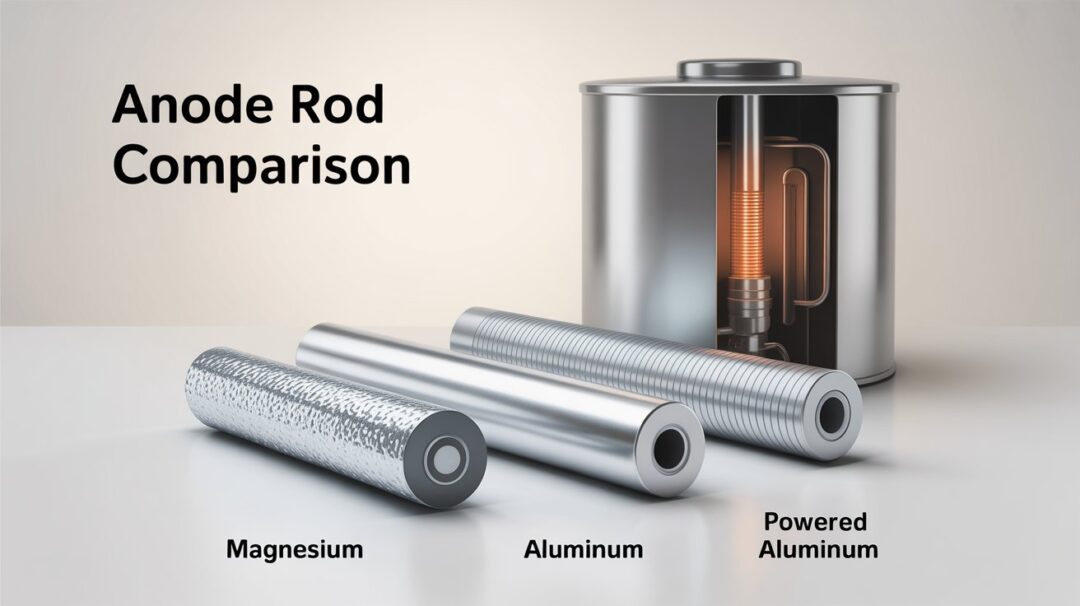
Extending Your Anode Rod’s Lifespan: Preventative Measures
Preventative measures play a crucial role in extending the lifespan of your anode rod and, by extension, your water heater. By implementing a few simple strategies, you can significantly improve the longevity and efficiency of your water heating system.
Water Temperature Management
Managing the temperature of your water heater is a crucial step in extending the life of your anode rod. High temperatures can accelerate the deterioration of the anode rod. Setting the temperature to a moderate level, around 120°F, can help reduce the rate of anode rod consumption without compromising your hot water needs.
Installing Multiple Anode Rods
For larger water heaters or those operating in highly corrosive environments, installing multiple anode rods can be an effective strategy. This approach distributes the sacrificial load across several rods, potentially doubling or tripling the lifespan of the anode rod system. It’s a proactive measure that can significantly delay the need for replacement.
Water Treatment Options to Reduce Corrosion
Implementing water treatment solutions can also help extend the life of your anode rod. Water softeners, for example, can reduce mineral content that contributes to corrosion. Additionally, installing a water filtration system can minimize the presence of corrosive elements in the water, thereby reducing the load on the anode rod.
| Preventative Measure | Benefit |
|---|---|
| Water Temperature Management | Reduces anode rod deterioration |
| Installing Multiple Anode Rods | Extends anode rod lifespan |
| Water Treatment Options | Minimizes corrosive elements |
Conclusion: Protecting Your Water Heater Investment Through Proper Anode Rod Maintenance
To protect your water heater investment, understanding when to replace the anode rod is crucial. Regular anode rod maintenance is essential for ensuring the longevity of your water heater.
Proper anode rod maintenance involves regular inspections and replacements according to the manufacturer’s recommended anode rod replacement schedule. By doing so, you can prevent accelerated tank corrosion and maintain the efficiency of your water heater.
The importance of anode rod maintenance cannot be overstated. Neglecting to replace the anode rod when necessary can lead to premature water heater failure, resulting in costly repairs or replacement.
By staying on top of anode rod maintenance, you can extend the life of your water heater and ensure it continues to operate efficiently. Knowing when to replace the anode rod is vital to protecting your investment.

